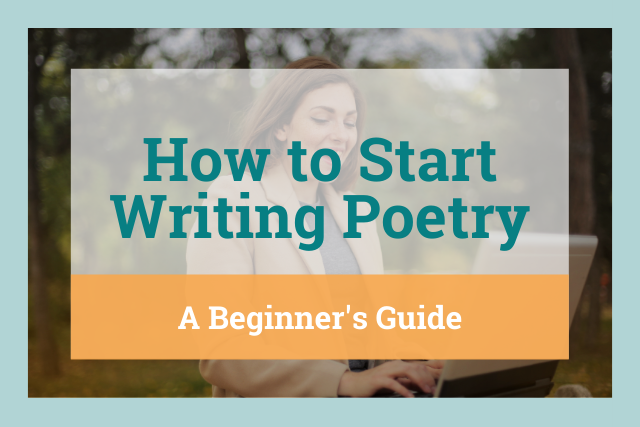
Poetry is a daunting art form to break into.
There are technically no rules for how to write a poem, but despite that—or perhaps because of it—learning how to write a successful poem might feel more difficult than learning how to write a successful essay or story.
There are many reasons to try your hand at poetry, even if you’re primarily a prose writer. Here are just a few:
- Practice writing stronger descriptions and imagery
- Unlock a new side of your creative writing practice
- Learn how to wield language in a more nuanced way
Learning how to write poetry may seem intimidating, but it doesn’t have to be.
In this article, we’ll cover five of our favorite tips to get started writing poetry.
How Do You Start Writing Poetry?
Tip 1: Focus on Concrete Imagery
One of the best ways to start writing poetry is to use concrete images that appeal to the five senses.
The idea of starting with the specific might feel counterintuitive, because many people think of poetry as a way to describe abstract ideas, such as death, joy, or sorrow.
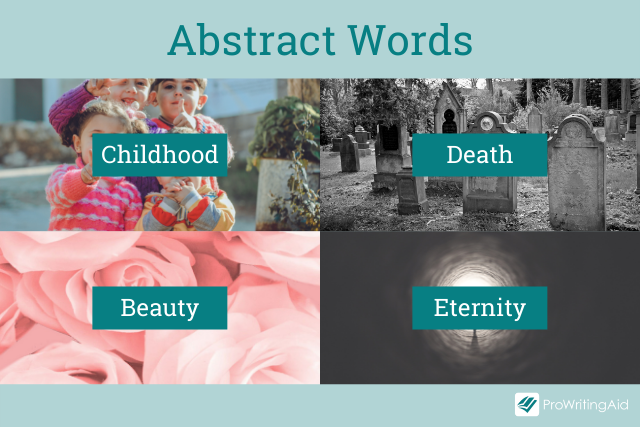
It certainly can be. But each of these concepts has been written about extensively before. Try sitting down and writing an original poem about joy—it’s hard to find something new to say about it.
If you write about a specific experience you’ve had that made you feel joy, that will almost certainly be unique, because nobody has lived the same experiences you have.
That’s what makes concrete imagery so powerful in poetry.
A concrete image is a detail that has a basis in something real or tangible. It could be the texture of your daughter’s hair as you braid it in the morning, or the smell of a food that reminds you of home.
The more specific the image is, the more vivid and effective the poem will become.
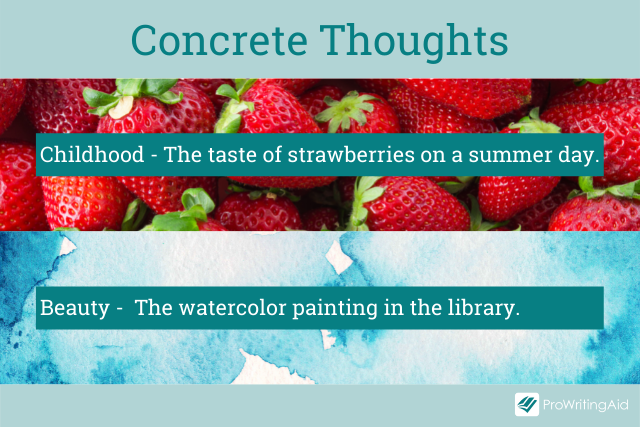
Concrete imagery: Example
Harlem by Langston Hughes
What happens to a dream deferred?
Does it dry up
like a raisin in the sun?
Or fester like a sore—
And then run?
Does it stink like rotten meat?
Or crust and sugar over—
like a syrupy sweet?
Maybe it just sags
like a heavy load.
Or does it explode?
Notice how Langston Hughes doesn’t directly write about dreams, except for the very first line. After the first line, he uses concrete images that are very specific and appeal to the five senses: “dry up like a raisin in the sun,” “stink like rotten meat,” “sags like a heavy load.”
He conveys a deeper message about an abstract concept—dreams—using these specific, tangible images.
Concrete Imagery: Exercise
Examine your surroundings. Describe what you see, hear, feel, taste, and smell.
Through these concrete images, try to evoke a specific feeling (e.g., nostalgia, boredom, happiness) without ever naming that feeling in the poem.
Once you've finished writing, you can use ProWritingAid’s Sensory Check to see which of the five senses you've used the most in your imagery. Most writers favor one or two senses, like in the example below, which can resonate with some readers but alienate others.
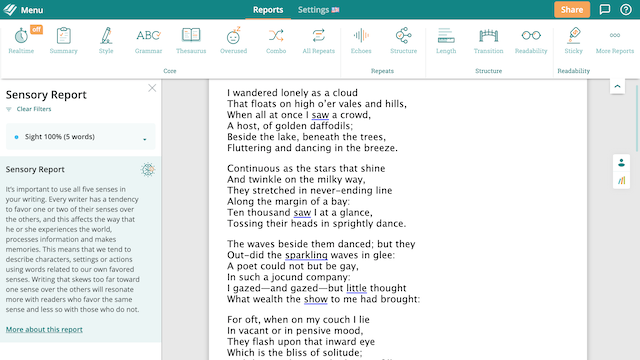
Sign up for a free ProWritingAid account to try the Sensory Check.
Bonus Tip: Start with a free verse poem, which is a poem with no set format or rhyme scheme. You can punctuate it the same way you would punctuate normal prose. Free verse is a great option for beginners, because it lets you write freely without limitations.
How Do You Write a Poem from a New Perspective?
Tip 2: Play with Perspective
A persona poem is a poem told in the first-person POV (point of view) from the perspective of anything or anyone. This could include a famous person, a figure from mythology, or even an inanimate object.
The word persona comes from the Latin word for mask. When you write a persona poem, it’s like you’re putting on a mask to see the world through a new lens.
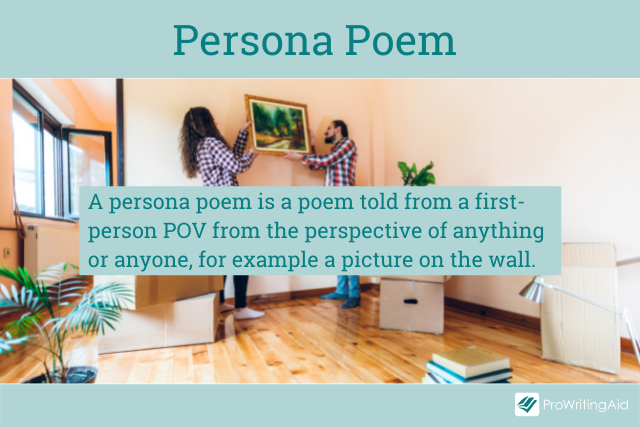
If you’re a new poet and you haven’t found your own voice yet, a persona poem is a great way to experiment with a unique style.
Some persona poems are narrative poems, which tell a story from a specific point of view. Others are lyric poems, which focus more on the style and sound of the poem instead of telling a story.
You can write from the perspective of a pop star, a politician, or a figure from fable or myth. You can try to imagine what it feels like to be a pair of jeans or a lawn mower or a fountain pen. There are no limits except your own creativity.
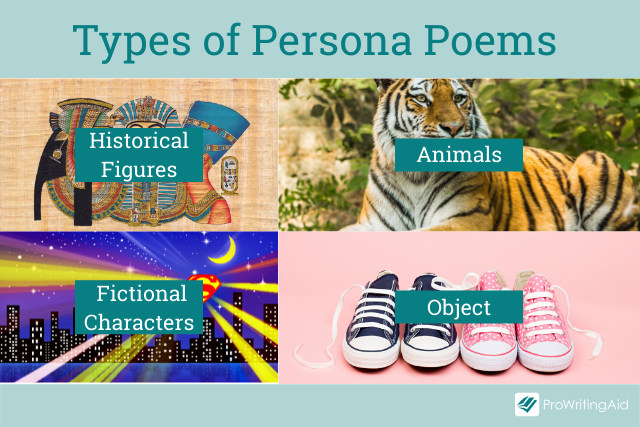
Play with Perspective: Example
Anne Hathaway by Carol Ann Duffy
Item I gyve unto my wief my second best bed … (from Shakespeare’s will)
The bed we loved in was a spinning world
of forests, castles, torchlight, cliff-tops, seas
where he would dive for pearls. My lover’s words
were shooting stars which fell to earth as kisses
on these lips; my body now a softer rhyme
to his, now echo, assonance; his touch
a verb dancing in the centre of a noun.
Some nights I dreamed he’d written me, the bed
a page beneath his writer’s hands. Romance
and drama played by touch, by scent, by taste.
In the other bed, the best, our guests dozed on,
dribbling their prose. My living laughing love—
I hold him in the casket of my widow’s head
as he held me upon that next best bed.
In this poem, Carol Ann Duffy writes from the perspective of Anne Hathaway, the wife of William Shakespeare.
She imagines what the wife of this famous literary figure might think and feel, with lines like “Some nights I dreamed he’d written me.”
The poem isn’t written in Shakespearean English, but it uses diction and vocabulary that’s more old-fashioned than the English we speak today, to evoke the feeling of Shakespeare’s time period.
Play with Perspective: Exercise
Write a persona poem from the perspective of a fictional character out of a book or movie. You can tell an important story from their life, or simply try to capture the feeling of being in their head for a moment.
If this character lives in a different time period or speaks in a specific dialect, try to capture that in the poem’s voice.
How Do You Write a Meaningful Poem?
Tip 3: Write from Life
The best poems are the ones that feel authentic and come from a place of truth.
Brainstorm your own personal experiences. Are there any stories from your life that evoke strong feelings for you? How can you tell that story through a poem?

Try to avoid clichés here. If you want to write about a universal experience or feeling, try to find an entry point into that feeling that’s unique to your life.
Maybe your first hobby was associated with a specific pair of shoes. Maybe your first encounter with shame came from breaking a specific promise to your grandfather. Any of these details could be the launching point for a poem.
Write from Life: Example
Discord in Childhood By D.H. Lawrence
Outside the house an ash-tree hung its terrible whips,
And at night when the wind arose, the lash of the tree
Shrieked and slashed the wind, as a ship’s
Weird rigging in a storm shrieks hideously.
Within the house two voices arose in anger, a slender lash
Whistling delirious rage, and the dreadful sound
Of a thick lash booming and bruising, until it drowned
The other voice in a silence of blood, ’neath the noise of the ash.
Here, D.H. Lawrence writes about the suffering he endured as a child listening to his parents arguing. He channels his own memories and experiences to create a profoundly relatable piece.
Write from Life: Exercise
Go to your phone’s camera roll, or a physical photo album, and find a photo from your life that speaks to you. Write a poem inspired by that photo.
What does that part of your life mean to you? What were your thoughts and feelings at that point in your life?
How Do You Write a Poem About a Theme?
Tip 4: Save the Theme for the End
In a poem, the last line is often the most important. These are the words that echo in your reader’s head after they’re done reading.
Many poems will tell a story or depict a series of images, allowing you to draw your own conclusions about what it’s trying to say, and then conclude with the takeaway at the very end. Think of it like a fable you might tell a child—often, the moral of the story comes at the end.
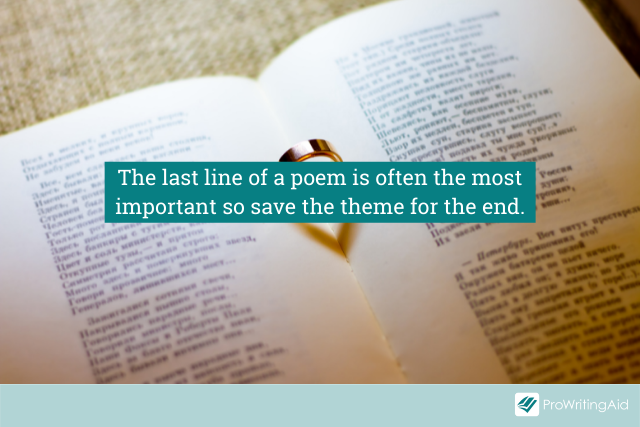
In sonnets it’s a common trend for the final couplet to summarize the theme of the whole poem.
Save the Theme: Example
Resumé by Dorothy Parker
Razors pain you;
Rivers are damp;
Acids stain you;
And drugs cause cramp.
Guns aren’t lawful;
Nooses give;
Gas smells awful;
You might as well live.
Here, Dorothy Parker doesn’t make the poem’s meaning clear until the very last line: “You might as well live.” The poem feels fun, almost like a song, and its true meaning doesn’t become obvious until after you’ve finished reading the poem.
Save the Theme: Exercise
Pick your favorite proverb or adage, such as “Actions speak louder than words.” Write a poem that uses that proverb or adage as the closing line.
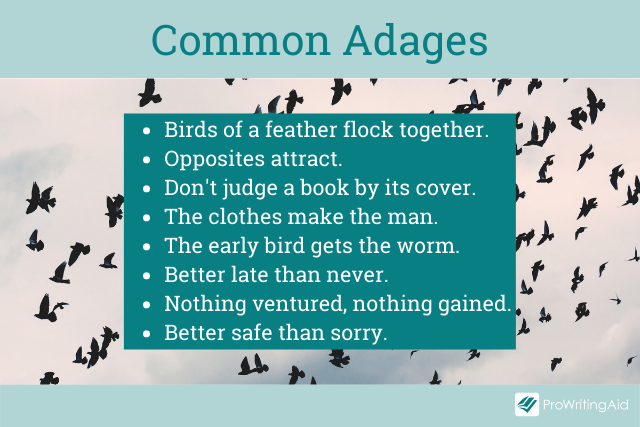
Until the closing line, don’t comment on the deeper meaning in the rest of the poem—instead, tell a story that builds up to that theme.
What Are Some Different Types of Poetry?
Tip 5: Try a Poetic Form
Up until now, we’ve been writing in blank verse because it’s the most freeing. Sometimes, though, adding limitations can spark creativity too.
You can use a traditional poetic form to create the structure and shape of your poem.
If you have a limited number of lines to use, you’ll concentrate more on being concise and focused. Great poetry is minimalistic—no word is unnecessary. Using a form is a way to practice paring back to the words you absolutely need, and to start thinking about sound and rhyme.
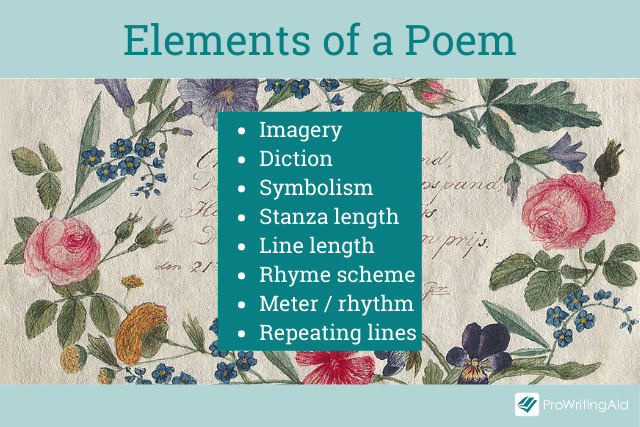
The rules of a poetic form are never set in stone. It’s okay to experiment, and to pick and choose which rules you want to follow. If you want to use a form’s rhyme scheme but ignore its syllable count, for example, that’s perfectly fine.
Let’s look at some examples of poetic forms you can try, and the benefits of each one.
Haiku
The haiku is a form of Japanese poetry made of three short, unrhymed lines. Traditionally, the first line contains 5 syllables, the second line contains 7 syllables, and the last contains 5 syllables.
Because each haiku must be incredibly concise, this form is a great way to practice economy of language and to learn how to convey a lot with a little. Even more so than with most other poetic forms, you have to think about each word and whether or not it pulls its weight in the poem as a whole.
The Old Pond by Matsuo Bashō
An old silent pond
A frog jumps into the pond—
Splash! Silence again.
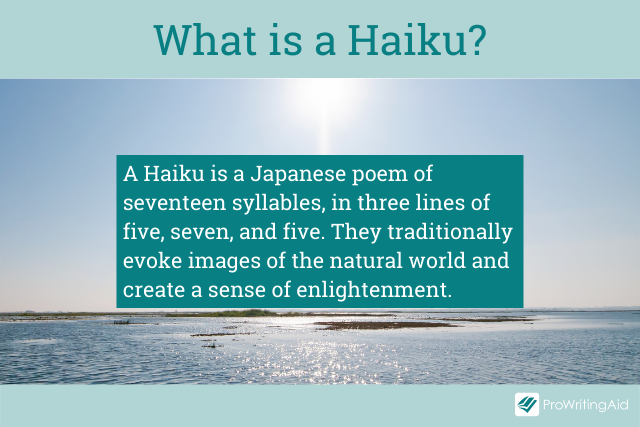
Limerick
The limerick is a 5-line poem with a sing-songy rhyme scheme and syllable count.
Limericks tend to be humorous and witty, so if you’re usually a comedic writer, they can be a great form for learning how to write poetry. You can treat the poem as a joke that builds up to a punchline.
Untitled Limerick by Edward Lear
There was an Old Man with a beard
Who said, "It is just as I feared!
Two Owls and a Hen,
Four Larks and a Wren,
Have all built their nests in my beard!"
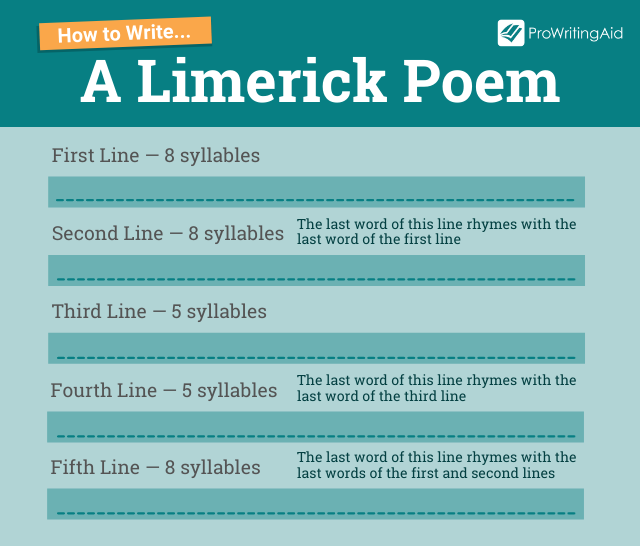
Sonnet
The sonnet is a 14-line poetic form, invented in Italy in the 13th century.
There are multiple types of sonnet. One of the most well-known forms is the Shakespearean sonnet, which is divided into three quatrains (4-line stanzas) and one couplet (2-line stanza).
Almost every professional poet has tried a sonnet at some point, from classical poets such as William Shakespeare, John Milton, and John Donne, as well as contemporary poets such as Kim Addonizio, R.S. Gwynn, and Cathy Park Hong.
Sonnets are great for practicing more advanced poetry. Their form forces you to think about rhyme and meter.
Sonnet 116 by William Shakespeare
Let me not to the marriage of true minds
Admit impediments. Love is not love
Which alters when it alteration finds,
Or bends with the remover to remove.
O no, it is an ever fixed mark
That looks on tempests and is never shaken;
It is the star to every wand’ring barque,
Whose worth’s unknown although his height be taken.
Love’s not time’s fool, though rosy lips and cheeks
Within his bending sickle’s compass come;
Love alters not with his brief hours and weeks,
But bears it out even to the edge of doom.
If this be error and upon me proved,
I never writ, nor no man ever loved.
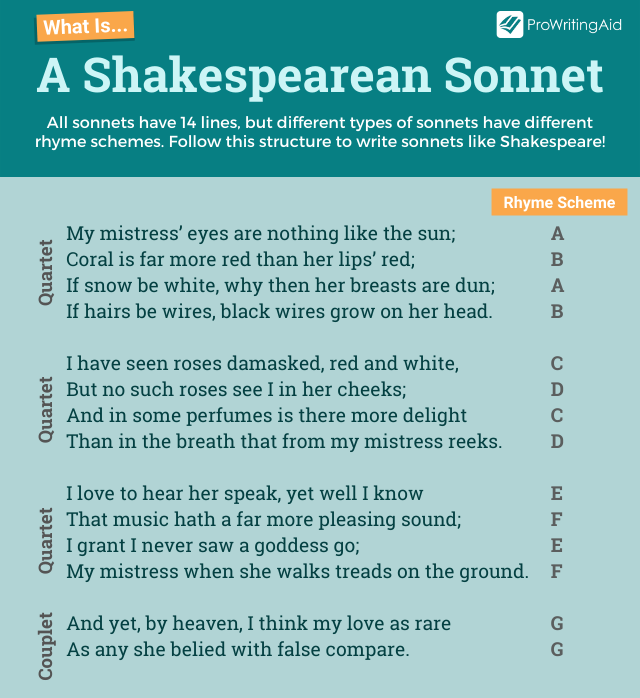
Villanelle
The villanelle is a 19-line poem with two lines that recur over and over throughout the poem.
The word “villanelle” comes from the Italian villanella, meaning rustic song or dance, because the two lines that are repeated resemble the chorus of a folk song. Using this form helps you to think about the sound and musicality of your writing.
Mad Girl’s Love Song by Sylvia Plath
I shut my eyes and all the world drops dead;
I lift my lids and all is born again.
(I think I made you up inside my head.)
The stars go waltzing out in blue and red,
And arbitrary blackness gallops in:
I shut my eyes and all the world drops dead.
I dreamed that you bewitched me into bed
And sung me moon-struck, kissed me quite insane.
(I think I made you up inside my head.)
God topples from the sky, hell’s fires fade:
Exit seraphim and Satan’s men:
I shut my eyes and all the world drops dead.
I fancied you’d return the way you said,
But I grow old and I forget your name.
(I think I made you up inside my head.)
I should have loved a thunderbird instead;
At least when spring comes they roar back again.
I shut my eyes and all the world drops dead.
(I think I made you up inside my head.)
Try a Poetic Form: Exercise
Pick your favorite poetic form (sonnet, limerick, haiku, or villanelle) and try writing a poem in that structure.
Remember that you don’t have to follow all the rules—pick the ones that spark your imagination, and ignore the ones that don’t.
Conclusion
These are our five favorite tips to get started writing poems. Feel free to try each of them, or to mix and match them to create something entirely new.
Have you tried any of these poetry methods before? Which ones are your favorites? Let us know in the comments.


